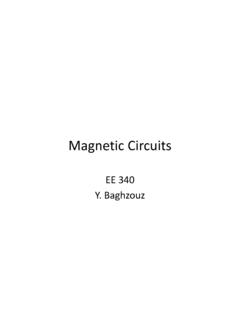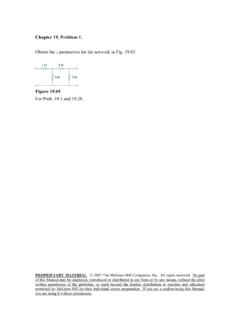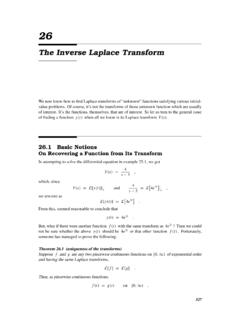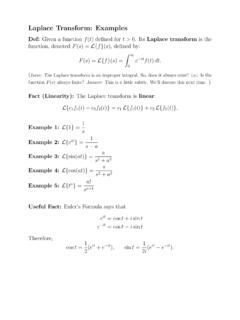Transcription of PowerPoint Presentation
1 laplace transform And Applications EE 221 Building the Definition laplace transform solution in s domain inverse laplace transform solution in time domain problem in time domain - Other Transforms Fourier transform Z- transform Wavelet- transform laplace Transformation linear differential equation time domain solution laplace transformed equation laplace solution time domain laplace domain or complex frequency domain algebra laplace transform inverse laplace transform The laplace transform The laplace transform of a function, f(t), is defined as; 0)()()]([dtetfsFtfLst js where The laplace transform laplace transform of the unit step.
2 |0011)]([ ststesdtetuLstuL1)]([ The laplace transform of a unit step is: s1 The laplace transform The laplace transform of a unit impulse: Pictorially, the unit impulse appears as follows: 0 t0 f(t) (t t0) Mathematically: (t t0) = 0 t t0 01)(000 dtttttThe laplace transform The laplace transform of a unit impulse: An important property of the unit impulse is a shifting or sampling property. The following is an important. 21201020100,0)()()(ttttttttttfdttttf The laplace transform The laplace transform of a unit impulse: In particular, if we let f(t) = (t) and take the laplace 1)()]([00 sstedtettL The laplace transform An important point to remember: )()(sFtf The above is a statement that f(t) and F(s) are transform pairs.
3 What this means is that for each f(t) there is a unique F(s) and for each F(s) there is a unique f(t). If we can remember the Pair relationships between approximately 10 of the laplace transform pairs we can go a long way. The laplace transform Building transform pairs: eL( etasstatatdtedteetueL0)(0)]([asasetueLst at 1)()]([|0astueat 1)( A transform pair The laplace transform Building transform pairs: 0)]([dttettuLst 000|vduuvudvu = t dv = e-stdt 21)(sttu A transform pair The laplace transform Building transform pairs: 22011212)()][cos(wssjwsjwsdteeewtLstjwtj wt 22)()cos( sstutA transform pair The laplace transform Time Shift 00)()()(.)
4 ,0,,)()]()([dxexfedxexfSoxtasandxatAsaxt anddtdxthenatxLeteatfatuatfLsxasaxsast)( )]()([sFeatuatfLas The laplace transform Frequency Shift 0)(0)()()]([)]([asFdtetfdtetfetfeLtassta tat)()]([asFtfeLat The laplace transform Example: Using Frequency Shift Find the L[e-atcos(wt)] In this case, f(t) = cos(wt) so, 2222)()()()(wasasasFandwsssF 22)()()()]cos([ asasteLatThe laplace transform Time Integration: The property is: ststtsttesvdtedvanddttfdudxxfuLetpartsby IntegratedtedxxfdttfL 1,)(,)(:)()(0000 The laplace transform Time Integration: Making these substitutions and carrying out The integration shows that )(1)(1)(00sFsdtetfsdttfLst The laplace transform Time Differentiation: If the L[f(t)] = F(s), we want to show: )0()(])([fssFdttdfL Integrate by parts: )(),()(,tfvsotdfdtdttdfdvanddtsedueustst The laplace transform Time Differentiation: Making the previous substitutions gives, 000)()0(0)()(|dtetfsfdtsetfetfdtdfLststs tSo we have shown: )0()()(fssFdttdfL The laplace transform Time Differentiation: We can extend the previous to show; )0(.
5 0(')0()()()0('')0(')0()()()0(')0()()()1( 212333222 nnnnnnffsfssFsdttdfLcasegeneralfsffssFsd ttdfLfsfsFsdttdfLThe laplace transform transform Pairs: _____)()(sFtf f(t) F(s) 12!111)(1)( nnstsntstasestut The laplace transform transform Pairs: f(t) F(s) 222212)cos()sin()(!1wsswtwswwtasnetasten atnat The laplace transform transform Pairs: f(t) F(s) 22222222sincos)cos(cossin)sin()()cos()() sin(wswswtwswswtwasaswtewaswwteatat The laplace transform Common transform Properties: f(t) F(s) )(10)()()()0( )0('2)0(1)()()()()]0([0),0()()(00),0()0( sFstdfdssdFttffnfsfnsfnssFnsndttfndasFtf atettfLsotetttutfsFsotetttuttf The laplace transform Theorem.)
6 Initial Value If the function f(t) and its first derivative are laplace transformable and f(t) Has the laplace transform F(s), and the exists, then )(limssF0)0()(lim)(lim tsftfssFThe utility of this theorem lies in not having to take the inverse of F(s) in order to find out the initial condition in the time domain. This is particularly useful in circuits and systems. Theorem: sInitial Value Theorem The laplace transform Initial Value Theorem: Example: Given; 225)1()2()( sssFFind f(0) 1)26(22lim25122lim5)1()2(lim)(lim)0(2222 2222222 ssssssssssssssssssFf s s s sThe laplace transform Theorem: Final Value Theorem: If the function f(t) and its first derivative are laplace transformable and f(t) has the laplace transform F(s), and the exists, then )(limssF s)()(lim)(lim ftfssF0 s tAgain, the utility of this theorem lies in not having to take the inverse of F(s) in order to find out the final value of f(t) in the time domain.
7 This is particularly useful in circuits and systems. Final Value Theorem The laplace transform Final Value Theorem: Example: Given: ttesFnotesssFt3cos)(3)2(3)2()(212222 Find )( f. 03)2(3)2(lim)(lim)(2222 sssssFf0 s0 sApply Initial- and Final-Value Theorems to this Example laplace transform of the function. Apply final-value theorem Apply initial-value theorem )4()2(2)( ssssF 41)40()20()0()0(2)(lim tft 0)4()2()()(2)(lim0 tft The Inverse laplace transform )()()(sDsNsF 31 Definition: F(s) is generally a ratio of two polynomials: Finding the inverse laplace transform of F(s) involves two steps: F(s) into simple terms using partial fraction expansion.
8 The inverse of each term by matching entries in laplace transform Table. jjtsdsesFjtfsFL )(21)()]([1 Partial Fraction Expansions 32)3()2(1 sBsAsss Expand into a term for each factor in the denominator. Recombine RHS Equate terms in s and constant terms. Solve. Each term is in a form so that inverse laplace transforms can be applied. )3()2(2)3()3()2(1 sssBsAsss3221)3()2(1 sssss1 BA123 BAThe Inverse laplace transform 46153)(2 ssssF0 t),())2sin(353(46153)(2111 tutesLsLsLtft33 Example: Find the inverse laplace transform of Solution: )1)(4(18892)(223 sssssssFExample of Solution of an ODE 0)0(')0(28622 yyydtdydtyd ODE w/initial conditions Apply laplace transform to each term Solve for Y(s) Apply partial fraction expansion Apply inverse laplace transform to each term ssYsYssYs/2)(8)(6)(2 )4()2(2)( ssssY)4(41)2(2141)( ssssY4241)(42tteety APPLICATION laplace transform TO CIRCUIT ANALYSIS 40 Example: Find v0(t) in the circuit shown below, assuming zero initial conditions.
9 41 Solution: transform the circuit from the time domain to the s-domain, we have sLtu3sC1 F31ss H 1s1 )( 42 Solution: Apply mesh analysis, on solving for V0(s) Taking the inverse transform give 220)2()4(223)(V ss0 V, )2sin(23)(40 ttetvt43 Example: Determine v0(t) in the circuit shown below, assuming zero initial conditions. V )()21(8 :Ans22tuteett 44 Example: Find v0(t) in the circuit shown below. Assume v0(0)=5V . V )()1510()( v:Ans20tueettt 45 Example: The switch shown below has been in position b for a long time.
10 It is moved to position a at t=0. Determine v(t) for t > 0. where0, t ,I)IV()( v:Ans0/00 RCReRtt 46 Example: Consider the circuit below. Find the value of the voltage across the capacitor assuming that the value of vs(t)=10u(t) V and assume that at t=0, -1A flows through the inductor and +5 is across the capacitor. 47 Solution: transform the circuit from time-domain (a) into s-domain (b) using laplace transform . On rearranging the terms, we have By taking the inverse transform , we get 230135V1 ssV )()3035()(v21tueettt 48 Example: The initial energy in the circuit below is zero at t=0.



















